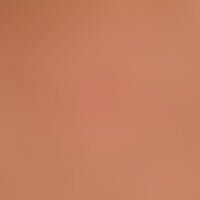Image diagnoses for "red"
876 results with 4456 images
Results forred

Basal cell carcinoma cystic C44.L
Basal cell carcinoma, cystic. 0.6 cm in diameter, slowly growing for several months, elastic, soft, glassy nodule with peripheral telangiectasia. 65-year-old woman.

Klippel-trénaunay syndrome Q87.2
Klippel-Trénaunay syndrome: extensive vascular malformation with extensive nevus flammeus affecting the trunk and both arms. So far no evidence of soft tissue hypertrophy. No AV fistulas.

Erysipelas A46
erysipelas. extensive redness and swelling of the left foot in a 71-year-old man. on the left back of the foot there is a sharply limited overheated erythema with flame-like runners of 15 x 15 cm in size. the back of the foot is circumferentially enlarged and painful. secondary findings are the palpation of single, enlarged, pressure-dolent lymph nodes in the corresponding lymph drainage area of the groin region.

Foot infection gram-negative L08.8

Syphilide papular A51.3

Erythronychia longitudinalis; L60.9 L60.8

Melkersson-rosenthal syndrome G51.2
Melkersson-Rosenthal syndrome. distinct erythema with doughy swelling in the region of the upper lip on the right side which extends to the nasolabial fold. distinct lingua plicata in a 50-year-old woman. whitish coatings are recognizable at the anterior edge of the tongue (minimal variant of a lingua geographica.

Folliculitis (superficial folliculitis) L01.0
Folliculitis (superficial folliculitis): 0.5 cm large, inflammatory, non-purulent follicular papules.

Tinea pedis (overview) B35.30
Tinea pedum: discrete, well defined, heart-shaped, slightly scaly erythema and hyperkeratosis on the right foot back of an 80-year-old female patient with exacerbated tinea pedum.

Erysipelas A46
Erysipelas, acute acute reddening of the back of the foot under high fever, sharply limited and extensive hemorrhagic blistering.

Borrelia lymphocytoma L98.8
Lymphadenosis cutis benigna. symptomless, solitary, soft, brown-red, hemispherically bulging nodules. smooth surface. unattractive environment.

Hypertrophic Lichen planus L43.81
Lichen planus verrucosus. solitary, chronically stationary, for months unchanged, very itchy, 5.0 cm large, rough, red, verrucous plaques on the lower leg. a highly chronic course over years is to be expected.

Asteatotic dermatitis L30.8
Desiccation dermatitis: slight, pityriasiform scaling with a characteristic craquelée pattern with linear cracking

Parapsoriasis en plaques large L41.4
Parapsoriasis en plaques large: asymptomatic , moderately sharply defined, disseminated patches and easily eliminated plaques on the trunk and extremities.

Tinea corporis B35.4
Tinea corporis:unusually elongated, non-pretreated, large-area tinea in known HIV infection

Urticaria (overview) L50.8
urticaria chronic spontaneous: multiple, chronically recurrent, reddish, partly confluent wheals, with peripheral vasoconstriction zone. severe itching. no scaling. note: the single episode lasts a maximum of 8-12 hours (detectable by marking test).

Erysipelas bullous
Erysipelas bullöses: acuteextensive, sharply defined, painful reddening and plaque with circumscribed large blisters; entry portal: tinea pedum.

Erysipelas A46
Erysipelas. circumscribed, fiery red, sharply defined erythema with extensive swelling of the skin. distinct tension pain in the affected areas. submandibular lymph nodes are dolent swollen, there is chills and fever.

Acne (overview) L70.0
Acne vulgaris (overview): large,inflammatory retention cyst next to comedones and a few smaller inflammatory papules

Syphilide papular A51.3
Syphilide, papular. multiple, acute, still increasing, generalized (trunk, extremities, palms of hands, soles of feet affected), predominantly isolated, 0.1-0.3 cm large, confluent in places (chest region), red or reddish-brownish, rough, slightly scaly spots. fatigue, generalized, non-painful lymphadenopathy, positive serology.




